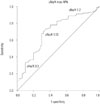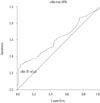Abstract
Purpose
Materials and Methods
Results
Figures and Tables
 | Fig. 1Receiver operating characteristic curve between C-reactive protein (CRP) and true acute pyelonephritis (APN) (area under the curve=0.836, 95% confidence interval=0.77-0.9, p=0.000) when the value of the state variable was 1. |
 | Fig. 2Receiver operating characteristic (ROC) curve between the urine sodium-potassium ratio (uNa/K) and true acute pyelonephritis (APN) (area under the ROC curve=0.698, 95% confidence interval=0.607-0.788, p=0.000) when the value of the state variable was 0. |
 | Fig. 3Receiver operating characteristic (ROC) curve between urine sodium (uNa) and true acute pyelonephritis (APN) (area under the ROC curve=0.602, 95% confidence interval=0.51-0.695, p=0.044) when the value of the state variable was 0. |
Table 1
Comparison of Laboratory Data between Infants with True APN and Controls

true APN, the presence of a cortical defect on DMSA scan; DMSA, dimercaptosuccinic acid renal scan; N, number of patients; U-test, Mann-Whitney's U test; T-test, Student's t-test; M, male; F, female; CRP, C-reactive protein; Na, sodium; K, potassium; Cl, chloride; T-CO2, total CO2; Cr, creatinine; Osm, osmolarity; TTKG, transtubular potassium gradient; FENa, fractional excretion of sodium.
The laboratory examination results are expressed as median and interquartile range.
*p<0.05.
Table 2
Comparison of Laboratory Data between Infants with UTI and Controls

UTI, urinary tract infection; U-test, Mann-Whitney's U test; T-test, Student's t-test; N, number of patients; M, male; F, female; CRP, C-reactive protein; Na, sodium; K, potassium; Cl, chloride; T-CO2, total CO2; Cr, creatinine; Osm, osmolarity; TTKG, transtubular potassium gradient; FENa, fractional excretion of sodium.
The laboratory examination results are expressed as the median and interquartile range.
*p<0.05.
Table 3
Comparison of Laboratory Data in Infants with UTI between Those with and without a Cortical Defect on DMSA Scanning

UTI, urinary tract infection; DMSA, dimercaptosuccinic acid renal scan; DMSA (+), the presence of a cortical defect on DMSA scanning; DMSA (-), the absence of a cortical defect on DMSA scanning; U-test, Mann-Whitney's U test; T-test, Student's t-test; N, number of patients; M, male; F, female; CRP, C-reactive protein; Na, sodium; K, potassium; Cl, chloride; T-CO2, total CO2; Cr, creatinine; Osm, osmolarity; TTKG, transtubular potassium gradient; FENa, fractional excretion of sodium.
The laboratory examination results are expressed as median and interquartile range.
*p<0.05.
Table 4
Comparison of Laboratory Data in Infants with UTI between Those with High and Low CRP Levels

UTI, urinary tract infection; U-test, Mann-Whitney's U-test; T-test, Student's t-test; N, number of patients; M, male; F, female; CRP, C-reactive protein; Na, sodium; K, potassium; Cl, chloride; T-CO2, total CO2; Cr, creatinine; Osm, osmolarity; TTKG, transtubular potassium gradient; FENa, fractional excretion of sodium; DMSA (+), the presence of a cortical defect on DMSA scanning.
The laboratory examination results are expressed as median and interquartile range.
*p<0.05.




 PDF
PDF ePub
ePub Citation
Citation Print
Print


 XML Download
XML Download